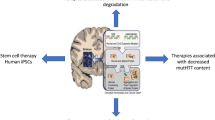Abstract
Polyglutamine (polyQ) diseases, including several types of spinocerebellar ataxias and Huntington's disease (HD), are dominantly inherited neurodegenerative disorders caused by the expansion of the glutamine-coding CAG repeat in the open reading frame of the disease gene. Apart from being translated to produce toxic elongated polyQ domain-containing disease proteins, transcribed expanded CAG RNAs per se also exert toxicity in polyQ degeneration. In the R6/2 HD transgenic mouse model, expanded mutant Huntingtin (Htt) transcripts were found to physically interact with nucleolin (NCL), a nucleolar protein that plays a crucial role in ribosome biogenesis. We further demonstrated that mutant Htt transcripts deprived NCL from binding onto the Upstream Control Element (UCE) of the ribosomal RNA (rRNA) promoter. This resulted in UCE hypermethylation which abolished the binding of the transcription factor Upstream Binding Factor to UCE and subsequently led to down-regulation of pre-45s rRNA transcription. We also found that the p53/mitochondria-dependent nucleolar stress cell death pathway was activated in polyQ diseases. Ribosomal RNA transcription dysfunction has been reported in other types of neurodegenerative disorders including Alzheimer's disease; it is anticipated that nucleolar stress is one common pathogenic signaling mechanism shared by different forms of neurodegeneration.

Similar content being viewed by others
References
Landles C, Bates GP. Huntingtin and the molecular pathogenesis of Huntington's disease. Fourth in molecular medicine review series. EMBO Rep. 2004;5:958–63.
Roos RA. Huntington's disease: a clinical review. Orphanet J Rare Dis. 2010;5:40.
Borrell-Pages M, Zala D, Humbert S, Saudou F. Huntington's disease: from huntingtin function and dysfunction to therapeutic strategies. Cell Mol Life Sci. 2006;63:2642–60.
Banez-Coronel M, Porta S, Kagerbauer B, Mateu-Huertas E, Pantano L, Ferrer I, et al. A pathogenic mechanism in Huntington's disease involves small CAG-repeated RNAs with neurotoxic activity. PLoS Genet. 2012;8:e1002481.
Li LB, Yu Z, Teng X, Bonini NM. RNA toxicity is a component of ataxin-3 degeneration in Drosophila. Nature. 2008;453:1107–11.
Zhang Y, Lu H. Signaling to p53: ribosomal proteins find their way. Cancer Cell. 2009;16:369–77.
Speidel D. Transcription-independent p53 apoptosis: an alternative route to death. Trends Cell Biol. 2010;20:14–24.
Ruggero D, Grisendi S, Piazza F, Rego E, Mari F, Rao PH, et al. Dyskeratosis congenita and cancer in mice deficient in ribosomal RNA modification. Science. 2003;299:259–62.
Parlato R, Kreiner G, Erdmann G, Rieker C, Stotz S, Savenkova E, et al. Activation of an endogenous suicide response after perturbation of rRNA synthesis leads to neurodegeneration in mice. J Neurosci. 2008;28:12759–64.
Pietrzak M, Rempala G, Nelson PT, Zheng JJ, Hetman M. Epigenetic silencing of nucleolar rRNA genes in Alzheimer's disease. PLoS One. 2011;6:e22585.
Tsoi H, Lau TC, Tsang SY, Lau KF, Chan HY. CAG expansion induces nucleolar stress in polyglutamine diseases. Proc Natl Acad Sci U S A. 2012;109:13428–33.
Ruggero D, Pandolfi PP. Does the ribosome translate cancer? Nat Rev Cancer. 2003;3:179–92.
Santoro R, Grummt I. Epigenetic mechanism of rRNA gene silencing: temporal order of NoRC-mediated histone modification, chromatin remodeling, and DNA methylation. Mol Cell Biol. 2005;25:2539–46.
Lee J, Hwang YJ, Boo JH, Han D, Kwon OK, Todorova K, et al. Dysregulation of upstream binding factor-1 acetylation at K352 is linked to impaired ribosomal DNA transcription in Huntington's disease. Cell Death Differ. 2011;18:1726–35.
Acknowledgments
This work was supported by a CUHK Biochemistry Department Collaborative Research Fund and the Hong Kong Research Grants Council General Research Fund Scheme.
Conflict of interest
The authors declare that they have no conflicts of interest and are aware of no individual or entity that would benefit from the studies described herein.
Author information
Authors and Affiliations
Corresponding author
Electronic supplementary material
Below is the link to the electronic supplementary material.
ESM 1
(DOC 26 kb)
Rights and permissions
About this article
Cite this article
Tsoi, H., Chan, H.Y.E. Expression of Expanded CAG Transcripts Triggers Nucleolar Stress in Huntington's Disease. Cerebellum 12, 310–312 (2013). https://doi.org/10.1007/s12311-012-0447-6
Published:
Issue Date:
DOI: https://doi.org/10.1007/s12311-012-0447-6




